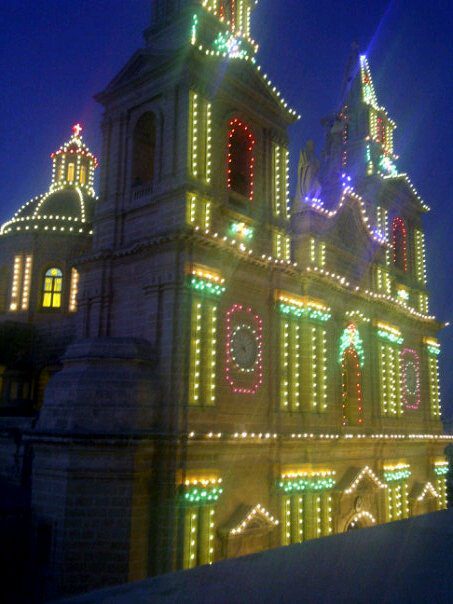The Feast
On August 30, the celebrations of the Mellieha Village Festa officially start. The statue of Our Lady is taken out of its niche. The nine-day period called “in-Novena” starts, a period in which several religious functions are organized at church, preparing those who attend with a spiritual feeling for the feast.
As the expected date of September 8 approaches, several musical programs are organized by the Mellieha Band Clubs; the Imperial Band Club and the La Vittoria Philharmonic Society. These two band clubs organize several band marches around the streets of Mellieha. These marches are organized between September 2 – 7, and are accompanied by several supporters.
During the festa week, from September 1 – 8, the Mellieha Parish Square is full of activities. In the Parish Square and the nearby areas you can find mobile kiosks selling hot-dogs, ice-creams, burgers, kebabs, chips, and all sort of fast food. One must also mention the delicious “mqaret”. “Mqaret” are pastry stuffed with a concoction of dates fried in oil. The traditional Maltese nougat sellers are also present, selling several types of delicious nougats.

One of the biggest factors that makes the Maltese village festas so unique, is the colorful fireworks. The fireworks light up the Mellieha skies, creating a merrier feeling among the present people. From about three days before September 8, ground fireworks, Maltese “giggifogu” (derived from Italian “guochi di fuoco”), start to light up the Mellieha Parish Square, with amazing effects. The principal show of ground fireworks is held on September 7, a show which ends at about 12.00am.
The band march known as “Il-Marc ta’ Fil-Ghodu” (the Morning March) is perhaps the peak of the feast for most people, practically in all Maltese village feasts. The hot shining sun of September doesn’t scare the present people away. The march roars through the streets of Mellieha with teenagers and others who are young at heart celebrating and enjoying themselves in front of the band playing some well-known Maltese band marches.
In the evening, the peak of the Village Festa is reached. At about 7pm the Statue of Our Lady leaves the Mellieha Parish Church, and goes through the nearby streets, carried on shoulders, and followed by a large amount of people. At about 10pm, the Statue arrives in front of the band clubs, and each band executes the Hymn of Our Patron, and another Marian Hymn.
In the evening, the peak of the Village Festa is reached. At about 7pm the Statue of Our Lady leaves the Mellieha Parish Church, and goes through the nearby streets, carried on shoulders, and followed by a large amount of people. At about 10pm, the Statue arrives in front of the band clubs, and each band executes the Hymn of Our Patron, and another Marian Hymn.
By that time, the Festa comes to an end. The crowd sings the Hail Mary, or Ave Maria, before the Statue enters the Church. A beautiful fireworks show is held, with vivid colors gliding and bursting in the sky, glowing over the picturesque village of Mellieha, and reflecting in the calm waters of the Mellieha Bay, Malta’s biggest sandy beach.
To many “Mellehin”, September 9 means the “Xalata”, a day in which most people go to the beach and enjoy themselves. The “Xalata” is present in all Maltese Village Festas, and nowadays can be nearly considered as another holiday.

The Statue
The Statue of Our Lady of Victories was sculptured by the famous Maltese woodcarver Pietru Pawl Azzopardi. It was commissioned by the Mellieha Parish, and paid by Don Giuseppe Di Stefano. The Statue of Our Lady of Victories was carved out of a bark of a tree.
September 8
September 8 recalls some of the most important historic events from the glorious and eventful history of the Maltese Islands. The main celebration, apart from the religious feast celebrated in Mellieha, Naxxar, Senglea, and in Xaghra, Gozo, is the commemoration of the victory of the Knights of St John and the Maltese in the Great Siege over the Ottoman Turks in 1565. In fact, a commemorative ceremony is still held annually in Valletta, by the Great Siege Monument in front of the Courts. Nowadays, September 8 is considered as one of the five National Holidays on the Maltese Islands.
On September 8, other historic events like the capitulation of the French in 1800, and the siege of the Axis powers in 1943 are commemorated.
September 8 is also linked with a particular tradition: the colorful and keenly contested boat race or regatta, which is held at the Grand Harbour in the afternoon, with many Maltese people crowding the nearby Grand Harbour area to watch this event.